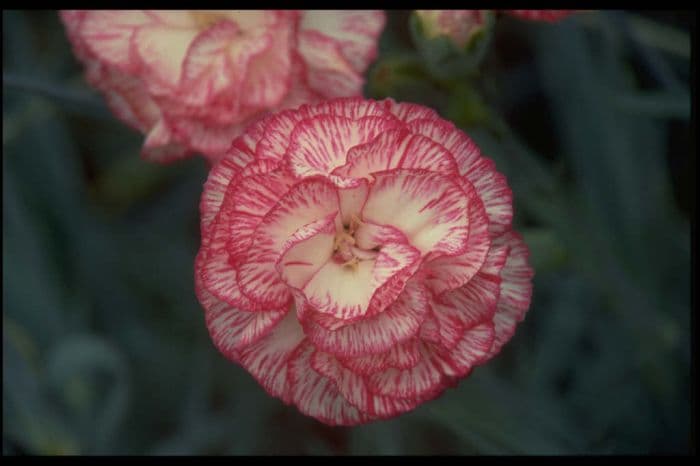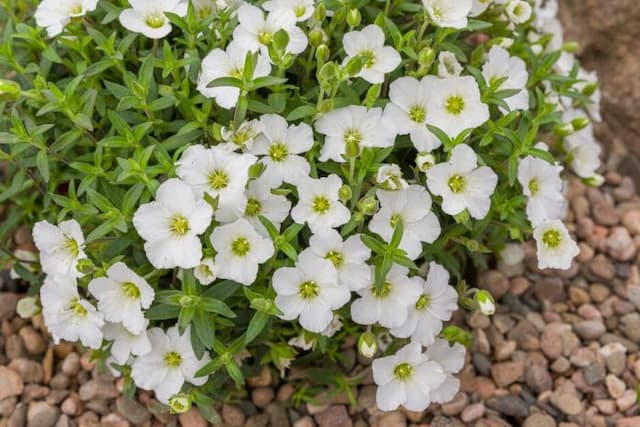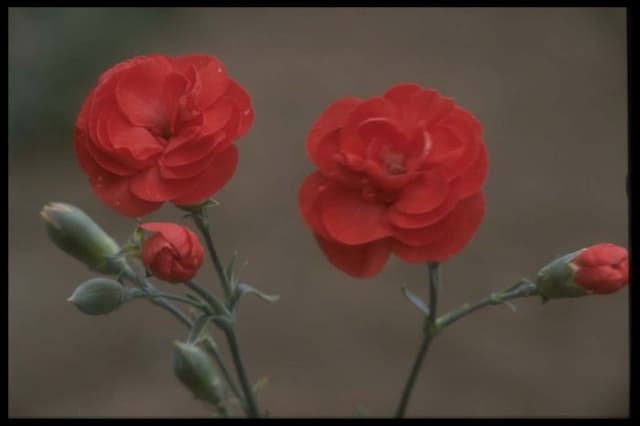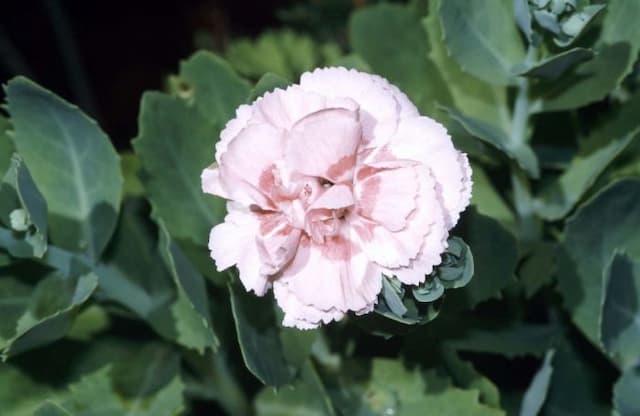Sweet William Dianthus 'Irene Della-torré' (b)

ABOUT
Dianthus 'Irene Della-torré' is a striking plant known commonly as Pinks, named for the frilled edges of the flowers that look like they were cut with pinking shears, rather than for their color. The blooms are typically vibrant and richly colored with varied hues that often include shades of pink, red, or purple, sometimes exhibiting multiple colors in a single bloom or featuring a beautiful pattern of contrasting rings or edges. They emit a spicy, clove-like fragrance that is highly appealing and adds an extra layer of sensory delight to gardens or arrangements. The foliage of Pinks is also quite distinctive. The leaves are slender, and typically a blue-green or grayish-green color, forming a neat, mound-like clump. This foliage contrasts nicely with the bright flowers, making for a plant that is visually well-balanced and appealing even when not in bloom. Overall, Pinks present a tidy, compact appearance with stiff, upright flowering stems that proudly display the fragrant blossoms. Their striking looks and pleasant aroma make them a favorite among gardeners and floral enthusiasts.
About this plant
 Names
NamesFamily
Caryophyllaceae
Synonyms
Sweet William, Pinks, Carnation
Common names
Dianthus 'Irene Della-torré'
 Toxicity
ToxicityTo humans
Dianthus, commonly known as "carnation," is not typically considered toxic to humans. However, some people may have a sensitivity to the plant which can lead to dermatitis or skin irritation upon contact. Ingesting parts of the plant is not advised, as it can cause mild gastrointestinal discomfort including nausea or an upset stomach, but serious poisoning is unlikely.
To pets
Carnation is generally considered to be of low toxicity to pets, but it might cause mild gastrointestinal upset if ingested. Common symptoms of ingestion can include vomiting, diarrhea, or a mild dermatitis if the pet comes into contact with the plant. Serious poisoning is rare, but it is always best to prevent pets from eating ornamental plants.
 Characteristics
CharacteristicsLife cycle
Perennials
Foliage type
Evergreen
Color of leaves
Green
Flower color
Pink
Height
1 foot [30 cm]
Spread
1 foot [30 cm]
Plant type
Herb
Hardiness zones
7
Native area
Europe
Benefits
 General Benefits
General Benefits- Ornamental Appeal: The Dianthus 'Irene Della-torré' adds aesthetic value to gardens with its vibrant flowers and distinctive fragrance.
- Low Maintenance: This plant is known for its easy care and low maintenance needs, making it suitable for gardeners of all skill levels.
- Drought Tolerance: Once established, it can tolerate periods of drought, reducing the need for frequent watering.
- Attracts Pollinators: The flowers attract bees and butterflies, which are essential for pollinating other plants in the garden.
- Long Blooming Period: It has a long flowering season, providing color and interest in the garden for an extended period.
- Cold Hardy: The plant is resistant to cold temperatures, making it a suitable choice for gardens in cooler climates.
- Versatility: It can be used in a variety of garden settings, including borders, rock gardens, and containers.
 Medical Properties
Medical PropertiesThis plant is not used for medical purposes.
 Air-purifying Qualities
Air-purifying QualitiesThis plant is not specifically known for air purifying qualities.
 Other Uses
Other Uses- Floral Arrangements: Dianthus flowers, including those of the 'Irene Della-torré' variety, are commonly used in bouquets and floral arrangements for their bright color and long-lasting nature.
- Garden Borders: The compact size and vibrant color of Dianthus make them ideal for creating striking borders in gardens.
- Container Gardening: Dianthus 'Irene Della-torré' can be grown in pots and containers, adding a splash of color to balconies, terraces, and patios.
- Culinary Garnish: The petals of Dianthus are edible and can be used to add a colorful touch to salads and desserts.
- Companion Planting: Dianthus plants can be used in vegetable gardens to attract pollinators and possibly deter some pests with their scent.
- Craft Projects: Dried Dianthus flowers can be used in various craft projects, such as making potpourri or decorative wreaths.
- Wedding Decor: Dianthus is a popular choice for wedding bouquets and decorations due to its symbolism associated with love and admiration.
- Photography: Because of their vivid color and texture, Dianthus flowers are often used as subjects for botanical photography.
- Butterfly Gardens: The Dianthus 'Irene Della-torré' can attract butterflies, making it a good choice for butterfly or wildlife gardens.
- Educational Use: Dianthus species can be used in educational settings, such as schools or botanical gardens, to teach about plant biology, pollination, and horticulture.
Interesting Facts
 Feng Shui
Feng ShuiThe Carnation is not used in Feng Shui practice.
 Zodiac Sign Compitability
Zodiac Sign CompitabilityThe Carnation is not used in astrology practice.
 Plant Symbolism
Plant Symbolism- Dianthus (Carnation): Symbolizes love, fascination, and distinction. Carnations carry different meanings depending on their color. Generally, they express love, admiration, and affection.
- Red Carnation: Deep romantic love, affection, and admiration. Traditionally, they convey feelings of deep love and affection.
- Pink Carnation: Symbol of a mother's undying love. According to Christian legend, pink carnations first appeared on Earth as Jesus carried the Cross, and the Virgin Mary shed tears, which grew into the flowers.
- White Carnation: Purity and luck. Often used in weddings and other ceremonies to denote pure love and good fortune.
- Striped Carnation: Regret or refusal. When given, they might indicate a regret that a love cannot be shared or an apology.
 Water
WaterCarnations, including the Dianthus 'Irene Della-torré', prefer to be watered thoroughly but infrequently, allowing the soil to dry out slightly between waterings. Generally, watering once a week with about one gallon per square yard during the growing season should suffice, adjusting for rainfall and temperature. Over winter, reduce watering but do not let the soil completely dry out. It is important to avoid overwatering, as carnations do not like to sit in soggy soil. A good practice is to check the top inch of the soil; if it's dry, it's time to water.
 Light
LightCarnations thrive best in full sun conditions, receiving at least six hours of direct sunlight each day. The ideal spot for a Dianthus 'Irene Della-torré' would be in an area where it is exposed to ample sunlight while still being protected from the harsh midday sun in very hot climates. Partial shade can also be suitable, especially in hotter regions, as long as there is plenty of bright light.
 Temperature
TemperatureCarnations prefer a temperate climate with temperatures ranging from 50 to 70 degrees Fahrenheit. They can tolerate temperatures as low as 40 degrees Fahrenheit and as high as 80 degrees Fahrenheit, but extreme temperatures outside this range can stress the plant. Ideally, maintaining a consistent temperature within the aforementioned range is best for the health and blooming of Dianthus 'Irene Della-torré'.
 Pruning
PruningPruning carnations is essential to promote vigorous growth and abundant flowering. For Dianthus 'Irene Della-torré', deadheading spent flowers encourages more blooms and prevents self-seeding. Light pruning can be done after the first flowering to maintain shape and encourage a second bloom. Pruning should be carried out with clean, sharp tools to minimize damage to the plant.
 Cleaning
CleaningAs needed
 Soil
SoilSweet William requires a well-draining soil mix composed of loam, sand, and organic compost with a pH that ranges from 6.0 to 7.5, with neutral pH being ideal.
 Repotting
RepottingSweet William should be repotted every one to two years or when it outgrows its current container, typically in the springtime.
 Humidity & Misting
Humidity & MistingSweet William thrives in average humidity levels; it does not require high humidity and fares well in normal outdoor conditions.
 Suitable locations
Suitable locationsIndoor
Keep in bright light, water sparingly.
Outdoor
Full sun, well-draining soil, moderate water.
Hardiness zone
3-9 USDA.
 Life cycle
Life cycleDianthus 'Irene Della-torré', commonly known as Pinks, starts its life cycle from seed, which when sown in fertile, well-draining soil and given adequate warmth and moisture, will germinate and sprout into seedlings. With sufficient light, the seedlings will develop true leaves and establish a root system, transitioning into the vegetative stage, where they focus on growing foliage and stems. After this phase, the plants enter the flowering stage, characterized by the development of buds that bloom into fragrant, colorful flowers, typically in late spring to early summer. During the flowering period, pollinators such as bees and butterflies may visit the flowers, assisting in the cross-pollination process. Following pollination, the flowers will produce seeds, completing the reproductive cycle. Finally, many varieties of Dianthus are perennial, meaning the plants may die back to the ground at the end of the growing season in fall or winter, only to regrow from their root system when conditions are favorable in the following spring.
 Propogation
PropogationPropogation time
Spring-Early Summer
Dianthus 'Irene Della-torré', known commonly as Pinks, is often propagated through softwood cuttings. The best time to take cuttings for propagation is late spring through early summer when the plant is growing vigorously. Firstly, select a healthy, non-flowering stem and cut a piece about 4 to 6 inches long. Remove the leaves from the lower half of the cutting and dip the cut end into rooting hormone powder to encourage root development. Insert the cutting into a mix of half perlite and half peat, watering it well. Place the cutting in a bright, indirect light location and maintain the moisture. Cuttings typically root in 2 to 4 weeks, after which they can be transplanted to individual pots or garden spaces.



![Pink [Tequila Sunrise]](/_next/image?url=https%3A%2F%2Fplants-admin.emdemapps.com%2Fimages%2Fplants%2F%2Fimages%2F604b5d995d06e.png&w=640&q=75)





